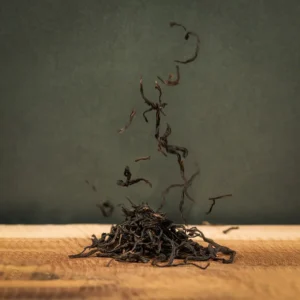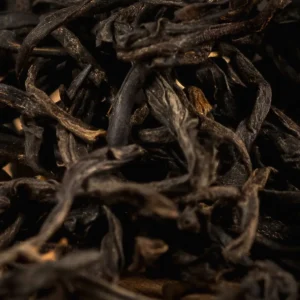Black tea
-

 Select options This product has multiple variants. The options may be chosen on the product page
Select options This product has multiple variants. The options may be chosen on the product page -


Warnagala Wild
From €12.00Select options This product has multiple variants. The options may be chosen on the product page
FAQ
While dubbed “black tea” in the West due to the dark color of the tea leaves, in Asian countries such as China and Japan it’s known as “red tea” or “hong cha” thanks to the color of the infusion itself.
Regardless of the name, black tea undergoes full oxidation, offering a robust, rich, and full-bodied profile, making it a global favorite. In fact, it constitutes a staggering 78% of the world’s tea production.
Read more about black tea in our blog.
To brew black tea it’s best to use very hot water, ideally between 90-95°C. Steeping time, water temperature, and tea-to-water ratio can vary based on personal preference. Always make sure the leaves have enough space to release all their robust and delicious flavors.
Black tea is also exceptionally delicious when cold brewed – accentuating sweetness and fruity notes.
If you’re unsure about the brewing process, visit our website or the packaging for detailed tea guidance. Ultimately, we encourage everyone to experiment and discover the method that best suits their taste.
Learn more about how to brew a delicious cup of tea.
It may not be a surprise to you that tea originated in China, black tea included. Yunnan province, in particular, is credited as the birthplace of this robust tea type. This dates back to the late Ming Dynasty (1368-1644) and early Qing Dynasty (1644-1912).
With time, black tea production spread to the West, reaching India where the flavors diversify with Assam’s strong, malty flavors and Darjeeling’s superbly fruity teas from the Himalayan foothills.
Meanwhile, in Sri Lanka (formerly Ceylon) the teas offer unique full-bodied flavors, fruity aromas, and a distinctive citrus finish unique to the island. African nations such as Malawi and Kenya also enrich the global black tea repertoire, each contributing their own remarkable flavors.
At Tea Kulture, sustainability and fair trade are at the heart of everything we do. We partner directly with farmers in the world’s prominent tea-producing regions who cultivate tea using natural, eco-friendly practices.
By ensuring fair wages and ethical working conditions, we support both the people and the planet. Our direct trade approach allows us to bring you premium-quality tea leaves while maintaining a commitment to fairness and environmental responsibility.
Read more about our story.
The enchantment of black tea production unfurls through a meticulous process that metamorphoses freshly plucked tea leaves into the deep, flavorful infusion we savor. Black tea processing promotes oxidation, causing the tea leaves to transition in color from green to a reddish-copper hue.
The steps are as follows:
• Harvesting: the leaves are plucked by the farmers.
• Withering: the plucked leaves release moisture, making them pliable.
• Rolling: this breaks down the cell walls and kickstarts the key oxidation process.
• Oxidation: the tea leaves are left to oxidize anywhere from 2 to 10 hours in a space where humidity and temperature are carefully controlled.
• Drying: this final step preserves the full-bodied flavors and enticing aromas, culminating in the transformation from fresh leaves to the robust essence of black tea.
Read more about black tea in our blog.
One of the most common debates surrounding tea involves its purported health benefits. While tea has a long history of being linked to medicinal properties, today’s wellness trends have increased scrutiny on these health claims.
For instance, black tea has been used in Traditional Chinese Medicine for centuries due to its warming properties and ability to stimulate blood flow. However, can it truly cure cancer, heart problems, and arthritis? We are cautious about making such claims.
True, tea does contain several beneficial compounds, including polyphenols (antioxidants), L-theanine (an amino acid), and alkaloids (with significant physiological effects). These components contribute to tea’s positive health effects, but definitive health outcomes are still uncertain.
At Tea Kulture, we encourage tea enthusiasts to view tea drinking as a healthy habit with positive benefits, rather than a medicinal cure.
Black tea tends to have the highest caffeine levels, as it steeps at high temperatures. While the oxidation of the tea is generally not an indicator of how much caffeine we will intake, the average caffeine content of black tea is typically 30-40 mg/cup, sometimes going up to 65 mg/cup. In comparison, an average cup of coffee contains about 95 mg of caffeine.
Please note that several factors contribute to the caffeine levels in tea: natural environment, fertilization, the part of the plant that was picked, seasonality, and of course, brewing time.
Read more about caffeine in tea.
Black tea, made from the Camellia Sinensis plant, contains a moderate amount of caffeine, which may interfere with sleep if consumed later in the day. If you’re sensitive to caffeine, it’s wise to avoid drinking black tea in the late afternoon or evening, as it might make falling asleep more difficult.
For a soothing, caffeine-free alternative, consider herbal infusions like chamomile or rooibos. These teas are naturally calming and promote relaxation without the stimulating effects of caffeine.
Properly storing tea is crucial to retain its freshness and flavor.
To preserve your black tea leaves, place them in an airtight, opaque container to shield them from oxygen, which may lead to oxidation and compromise their aroma. Store your tea in a cool, dark location, away from sunlight and heat sources.
Ensure the storage area remains dry to prevent moisture absorption, which can degrade the tea’s quality. Avoid placing your tea near strong odors to prevent flavor contamination.
By investing in high-quality tea leaves and storing them correctly, you can prolong the retention of their intricate flavors for extended periods.
Read more on how to store loose-leaf tea.
Tea Kulture
© 2024 Tea Kulture | All Right Reserved
Payment Methods

